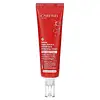What's inside
What's inside
 Key Ingredients
Key Ingredients

 Benefits
Benefits

 Concerns
Concerns

 Ingredients Side-by-side
Ingredients Side-by-side

Water
Skin ConditioningCaprylic/Capric Triglyceride
MaskingGlycerin
Humectant1,2-Hexanediol
Skin ConditioningAlpha-Arbutin
AntioxidantNiacinamide 2%
SmoothingCetearyl Alcohol
EmollientCetearyl Olivate
Titanium Dioxide
Cosmetic ColorantGlutathione
Hydrolyzed Collagen Extract
Skin ProtectingSorbitan Olivate
EmulsifyingAmmonium Polyacryloyldimethyl Taurate
Emulsion StabilisingVinyldimethicone
Glyceryl Stearate
EmollientPolymethylsilsesquioxane
Isononyl Isononanoate
EmollientT-Butyl Alcohol
PerfumingPolyhydroxystearic Acid
EmulsifyingAluminum Hydroxide
EmollientEthoxydiglycol
HumectantButyric Acid
MaskingGlycol
HumectantOctyldodecanol
EmollientEthylhexylglycerin
Skin ConditioningAsiaticoside
AntioxidantHydrogenated Lecithin
EmulsifyingAsiatic Acid
Skin ConditioningMadecassic Acid
Skin ConditioningGlycolipids
Skin ConditioningC12-13 Pareth-9
EmulsifyingPueraria Lobata Root Extract
HumectantPinus Palustris Leaf Extract
TonicUlmus Davidiana Root Extract
Skin ConditioningOenothera Biennis Flower/Leaf/Stem Extract
Skin ConditioningParfum
MaskingHexyl Cinnamal
PerfumingLinalool
PerfumingLimonene
PerfumingWater, Caprylic/Capric Triglyceride, Glycerin, 1,2-Hexanediol, Alpha-Arbutin, Niacinamide 2%, Cetearyl Alcohol, Cetearyl Olivate, Titanium Dioxide, Glutathione, Hydrolyzed Collagen Extract, Sorbitan Olivate, Ammonium Polyacryloyldimethyl Taurate, Vinyldimethicone, Glyceryl Stearate, Polymethylsilsesquioxane, Isononyl Isononanoate, T-Butyl Alcohol, Polyhydroxystearic Acid, Aluminum Hydroxide, Ethoxydiglycol, Butyric Acid, Glycol, Octyldodecanol, Ethylhexylglycerin, Asiaticoside, Hydrogenated Lecithin, Asiatic Acid, Madecassic Acid, Glycolipids, C12-13 Pareth-9, Pueraria Lobata Root Extract, Pinus Palustris Leaf Extract, Ulmus Davidiana Root Extract, Oenothera Biennis Flower/Leaf/Stem Extract, Parfum, Hexyl Cinnamal, Linalool, Limonene
 Reviews
Reviews

Ingredients Explained
These ingredients are found in both products.
Ingredients higher up in an ingredient list are typically present in a larger amount.
Ethoxydiglycol is a synthetic solvent.
Solvents are used to keep ingredients together in a product. They can help dissolve ingredients to stable bases or help evenly distribute ingredients throughout the product.
Ethoxydiglycol also helps deliver other key ingredients into the skin.
Learn more about EthoxydiglycolNiacinamide is a multitasking form of vitamin B3 that strengthens the skin barrier, reduces pores and dark spots, regulates oil, and improves signs of aging.
And the best part? It's gentle and well-tolerated by most skin types, including sensitive and reactive skin.
You might have heard of "niacin flush", or the reddening of skin that causes itchiness. Niacinamide has not been found to cause this.
In very rare cases, some individuals may not be able to tolerate niacinamide at all or experience an allergic reaction to it.
If you are experiencing flaking, irritation, and dryness with this ingredient, be sure to double check all your products as this ingredient can be found in all categories of skincare.
When incorporating niacinamide into your routine, look out for concentration amounts. Typically, 5% niacinamide provides benefits such as fading dark spots. However, if you have sensitive skin, it is better to begin with a smaller concentration.
When you apply niacinamide to your skin, your body converts it into nicotinamide adenine dinucleotide (NAD). NAD is an essential coenzyme that is already found in your cells as "fuel" and powers countless biological processes.
In your skin, NAD helps repair cell damage, produce new healthy cells, support collagen production, strengthen the skin barrier, and fight environmental stressors (like UV and pollution).
Our natural NAD levels start to decline with age, leading to slower skin repair, visible aging, and a weaker skin barrier. By providing your skin niacinamide, you're recharging your skin's NAD levels. This leads to stronger, healthier, and younger looking skin.
Another name for vitamin B3 is nicotinamide. This vitamin is water-soluble and our bodies don't store it. We obtain Vitamin B3 from either food or skincare. Meat, fish, wheat, yeast, and leafy greens contain vitamin B3.
The type of niacinamide used in skincare is synthetically created.
Learn more about NiacinamideWater. It's the most common cosmetic ingredient of all. You'll usually see it at the top of ingredient lists, meaning that it makes up the largest part of the product.
So why is it so popular? Water most often acts as a solvent - this means that it helps dissolve other ingredients into the formulation.
You'll also recognize water as that liquid we all need to stay alive. If you see this, drink a glass of water. Stay hydrated!
Learn more about Water